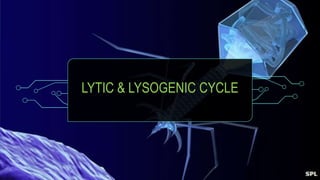
Lytic & Lysogenic Cycle
- 1. LYTIC & LYSOGENIC CYCLE
- 2. LYTIC CYCLE: • It is commonly referred as the reproductive cycle of the bacteriophage. • A virus undergoes lytic and lysogenic cycles to reproduce. • It is relatively more common, wherein a virus infects a host cell, use its metabolism to multiply and destroy the cell completely.
- 3. STEPS OF THE LYTIC CYCLE 1.ATTACHMENT 2.PENETRATION 3.SYNTHESIS 4.ASSEMBLY 5.RELEASE
- 4. 1.ATTACHMENT • A virus requires a host cell for multiplication. • In a first step, a virus attaches itself onto the host cell. • The virus may attach itself on the receptor of the cell, or simply any other part on its surface. • In some cases, a small part of the viruses attaches to the host, instead of the virus itself.
- 5. 2.PENETRATION • Once attached, the virus the gains access to the cell body by breaking through the cell’s plasma membrane. • In some cases, the cell wall tail fibres of the virus and enzymes released by it help in breaking through the same. • The virus then release its genetic material into the host cell. • The cell is now said to be infected.
- 6. 3.SEIZURE OF CELL MECHANISM • The infected DNA or RNA then hijacks the host cell’s genetic material and mangles with its gene expression. If DNA is injected: • The virus DNA transcribes itself into mRNA molecules. • This molecules can control the host’s ribosome. • Thus, the virus gains control of the host cell’s mechanism.
- 7. If RNA is injected: • An enzyme called reverse transcriptase transcribes the virus’s RNA into DNA. • This DNA is again transcribed into mRNA molecules. • Thus it take over the mechanism. • The virus takes over the cell machinery to produce multiple viral components. • Simply put the virus infects the host to produce more virus parts. • Also virus puts the host nucleotides to work and replicate its own genetic material.
- 8. 4.VIRUS MULTIPLICATION AND CELL DESTRUCTION • Now that the genetic material as well as viral parts are replicated, the host metabolism assembles new viruses from scratch. • The capsid are assembled, followed by the genetic material in the head and finally the tail fibre is attached to the end portion. • Eventually, the host cell is filled with viruses. • Once the assembly is completed, the virus releases an enzyme that disintegrates the cell wall from within. • Thus, destructing the host cell. • The virus are individual and free now.
- 11. 1.PENETRATION: • Once the virus’s genetic material is inserted, it attaches itself to that of the host’s. • Some viruses may not immediately start multiplying or replicating after infecting the cell. • In case it does not start replicating, the virus is said to be dormant. • The virus genetic material is known as Prophage, while it is in the dormant stage.
- 12. 2.REPLICATION OF GENETIC MATERIAL • Thereafter, the cell will fall back into its regular metabolic activities and eventually prepare for cell division. • The genetic material or nucleic acid replicates, and the nucleus divided into two parts. • Each part having the same genetic information.
- 13. 3.CELL DIVISION • The cell organelles will be replicated (in some cells) followed by division of the cell body, resulting in two daughter cells. • Each having virus’s genetic information incorporated to their genetic material. • The cells have utter normally until the virus is triggered. • This daughter cells carrying the viral genetic material are known as Lysogenic cycle
- 14. REFERENCE: 1.DAVID FREIFELDER, TEXTBOOK OF MOLECULAR BIOLOGY, PAGE NO: 553-560. This Photo by Unknown Author is licensed under CC BY
- 15. THANK YOU This Photo by Unknown Author is licensed under CC BY-SA